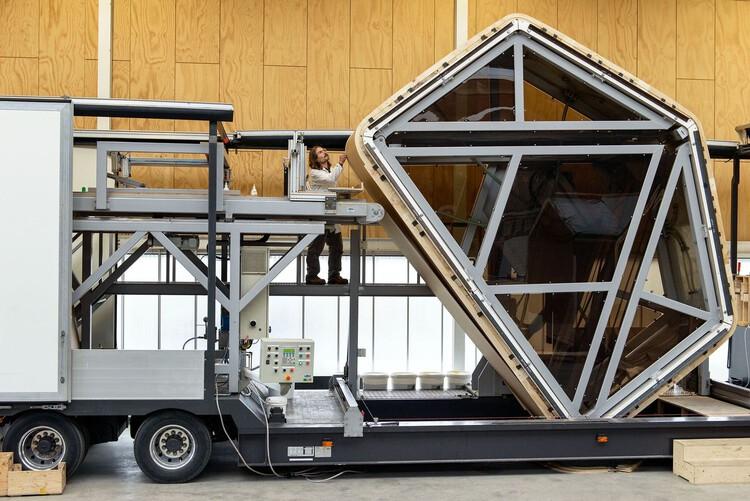In Short : Emerging technologies are reshaping architecture towards sustainability. From green materials and energy-efficient design to IoT-driven smart systems and urban planning tools, innovations are fostering eco-friendly buildings and cities. Prefabrication, renewable energy integration, and waste reduction techniques further enhance the industry’s environmental responsibility, ensuring a greener future.
In Detail : When we talk about technology, we often think of robots, supercomputers, data centers or smartphones. But technology also refers to the invention of the first chipped stone tools or the development of the steam engine, which brought about the first Industrial Revolution. The term comes from the combination of the Greek words techne (art, craft) and logos (word, speech) and is nothing more than the application of knowledge to achieve goals in a specific and reproducible way, for practical purposes. In the construction industry, which moves large amounts of resources and people, more technology means incorporating new methods, tools, automation and software that can improve efficiency. As a historically innovation-resistant industry, the construction sector has a huge impact on the environment due to its carbon emissions and exploitation of raw materials. However, as it turns to the digital world, builders have seen technology as a means to optimize practices and identify, build, and manage their projects.
The fundamental principles behind sustainable buildings include reducing resource consumption (energy and water efficiency), maximizing the use of renewable or recyclable resources, protecting the natural environment, and creating a healthy environment for users. This is particularly relevant if one considers the large impact of the industry and buildings on greenhouse gas emissions and the growing demand for new housing around the world, as the urban population continues to increase. As Sami Atiya, president of Robotics and Automation at ABB, points out, “Construction is where the automotive industry was about 50 years ago in terms of the density of robots and automation. It’s coming from a lower base, but it is going to grow much faster.” Below we have listed some technologies that can actively contribute to making buildings more sustainable and, even if they are not exactly new, have shown promise.
Building Information Modelling (BIM) and the increased control of processes
Today, BIM is increasingly used to improve the control and management of designs. It is a methodology that digitally and three-dimensionally represents the physical and functional characteristics of a building, allowing professionals from different areas to work together in the elaboration of a precise and detailed virtual model, with valuable information to build and mantain a building. Unlike CAD (Computer Aided Design), which creates two-dimensional lines without distinguishing between elements, BIM incorporates multiple properties into each element, in addition to their graphic representation. This enables users to intelligently manage information throughout a project’s lifecycle, automating processes such as programming, conceptual design, detailing, analysis, documentation, manufacturing, construction logistics, operation and maintenance, renovation, and/or demolition.
The technology allows interdisciplinarity between the different fields of knowledge involved in the design. It ends up interfering with the traditional dynamics of project phasing, demanding a review of the stages and their respective scopes. The BIM system has been modernizing and integrating itself more and more into the cloud and with laser scanning, as well as allowing more accurate energy simulations (which interferes with the performance of new buildings).
Industrialized, modular and prefabricated construction
Prefabricated buildings are also far from new. Especially after World War II, European and North American countries saw many examples of catalog buildings, mainly residences. Today, however, innovative digital tools are greatly facilitating prefabrication, with the aforementioned BIM allowing for more accurate representation and integration with other stakeholders. This allows the manufacturing of ready or semi-ready modules in factories, reducing construction time and the number of errors and waste.
This can also make buildings more versatile, with the possibility of adapting them to the different needs that may arise over time and even to social and regional particularities, through the incorporation of elements (porches, internal courtyards), the distribution of environments or local materials for coatings and structure.
Digital Twins in advanced building methods
When we talk about a “Digital Twin” we refer to an exact digital representation of an object or a physical asset, such as a car, a bridge, or a building. But more than just a simplistic three-dimensional model, it is an informational model, with all the project’s details from the planning stage to its operation, maintenance, and information about future use or reuse. Essentially, Digital Twins are dynamic, active entities that evolve in real-time, learning and updating themselves thanks to Artificial Intelligence. They can communicate with their physical twins in order to solve problems before they even occur, evaluate new opportunities, and prepare for the future.
According to Renaud Jahan, Chief Information Officer Innovation at Saint-Gobain, “Digital twins make it possible to simulate processes, materials and systems and develop construction scenarios while optimizing energy efficiency, and also provide real evidence data on what the product really is and where it is located on an operative level.”
For example, machine learning algorithms or pre-programmed software sequences can make a climate control system much more economical. In addition to changing the intensity of airflow and temperature depending on the weather, the system can learn and understand the demands of each floor, at any time of day, and even take information from weather models or the possible occupancy of a room during an event. This is particularly important since much of the carbon footprint of buildings is emitted in their operational phase, which typically is not given enough importance.

